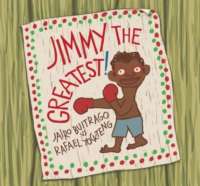
Jimmy lives in a small Caribbean town where there’s not a whole lot to do. Fortunately though, there is a boxing gym, and one day the owner, Don Apolinar, suggests that Jimmy start training. He also gives Jimmy a cardboard box full of books and newspaper clippings all about Muhammad Ali. Jimmy reads and re-reads as he never has before. He is swept with admiration for Ali who said, “I am the greatest. I said that even before I knew I was.” He starts to feel good, realizing that he doesn’t need to have a lot of fancy stuff, that he’s a pretty good boxer himself, and that he can look forward to the future. But by the time Don Apolinar has to leave for the big city, Jimmy realizes that he can have a great life running the gym, creating a library, dancing and boxing . . . right where he is.Jairo Buitrago’s simple yet inspiring story is complemented by Rafael Yockteng’s funny, expressive illustrations, making this a book that will speak to many young readers.The Spanish edition, ¡Jimmy, el más grande!, was recently named one of “Los mejores libros del año” (Best Books of the Year) by Venezuela’s Banco del Libro.
- ISBN: 9781554981786
- Published: 2012
- Themes: boxing, growing up, Poverty, Sports
- Descriptors: Caribbean, Early Years (ages 2-6), Picture Book
- No. of pages: 48

Tracy: I love the book because it really is an attempt to stay authentic to the place where Jimmy lives. It gives a glimpse into a culture and people in a very contemporary time of life on how an island community lives, but not in a tourist island way, rather that of the people who’ve lived on the island for generations. It doesn’t try to show the life or history of the island’s residents as exotic, or gloss over that life is hard on this island. The author and illustrator were not trying to be political by showing the life on this island as being hard. They portrayed what it life is like in this type of setting. For example, the story tells about Jimmy’s stolen shoes, his coach had to leave the village to go find work, and that there are no boxing gloves at the gym.
Kathleen: A couple of times in the story you hear Jimmy’s voice through poetry. The text changes color to signify his actual voice. In these two different narratives you see Jimmy’s true identity come through. The reader sees that he “Loved to talk about strange things like respect and dignity, though people didn’t always listen.” I missed the meaning of this sentence the first read through. But after reading through the book several times, and seeing who Jimmy really was, I realized how important it is to linger on this page with students. It is such a short little sentence that is beautifully illustrated with Jimmy and two children looking out at a nighttime view of the ocean. It just calls the reader to view and listen to the text and illustration.
Tracy: It has a hopeful ending, which is expected in a children’s book, but there is no happily ever after resolution. The author was very smart in ending it by saying, “…. There’s me, Jimmy – Jimmy the Greatest.” He has pride in himself. The author didn’t portray a happy ending where he might have become a famous boxer. There is kind of a transformation where he learned about Mohammad Ali.
Kathleen: Yes, I agree about the transformation. The story really celebrates Jimmy’s identity and his life style. The poem at the end that resembles the voice of Mohammad Ali shows who Jimmy is now. It reminds me of the impact Mohammad Ali had on people, in particular, kids who did not grow up in privilege. Jimmy could identify with who Mohammad Ali was and what he stood for.
Tracy: I don’t think I really came to appreciate who Mohammad Ali was and what he did until my adult life. He was a lightening rod for criticism and fearless when it came to taking political stances. He walked the talk, as one of the greatest athletes alive. I like how Jimmy gained inspiration from the hardships of Mohammad Ali. This inspiration was threaded throughout the story. It really celebrates the resiliency of people to adapt to their conditions and environments. It does not paint the people living on Jimmy’s island home in a “pity me” way.
Kathleen: As we are talking about the issue of identity, I can’t help think about what has happened in Connecticut this past week. I wonder how things might be different in our schools if all children had the opportunity to explore their own “sense of self,” like Jimmy did. It really makes you ponder upon the importance of providing a learning environment for all students to find and develop their strengths, not just the average student. Our classrooms need to adjust to every learner, and the multitude of complexities that come with different learners. I question who can be the type of role model for our students that can provide the inspiration needed to feel accepted in our communities. This book demonstrates the importance of self-identity that Jimmy doesn’t have to leave his small community to discover himself because he was provided the opportunity through mentors both through his coach and through the readings of Mohammad Ali to live his best life. So if we want our students to live their best lives we need to consider adjusting our curriculum to fit the learner.